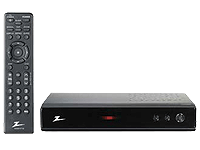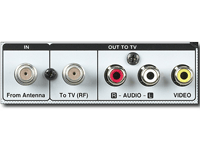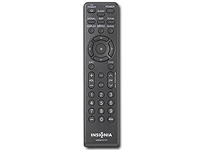Next February, analog TVs that depend on antennas will go to snow.

Your old TV will still work this February, if you follow these steps.
On February 17, 2009, millions of TVs across the U.S. will go blank, displaying the snowy screen that for decades has meant the lack of a TV signal. No matter which channel their owners tune to, or how long they wait, the snow will remain. When this happens, thousands of Americans will ask their local TV station, landlord, caregiver, or tech-savvy relative for an explanation. If the person they ask happens to be you, this guide will give you the answers. If you happen to be someone who watches analog TV using an antenna, read on to find out how you can save your old TV from a snowy death for about $20 or less.
What is changing, and why?
The U.S. government, after more than 10 years trying to work with TV broadcasters and consumer electronics companies, decreed that February 17, 2009, is the date when almost all over-the-air analog TV broadcasts will cease.
One reason for turning off analog broadcasts has to do with technological progress. The old method of broadcasting TV over-the-air, perfected in the 1940s using analog signals, is incredibly inefficient compared with the new method using digital television (DTV) signals. Just as a car works better than a horse and buggy does covering long distances, digital works better than analog when broadcasting TV signals (and conveying many other kinds of information).
Another big reason is money. In March 2008, the FCC held an auction to sell off the “spectrum,” or the part of the airwaves that used to carry analog TV broadcasts, to private companies, which netted the government a record $19.6 billion. Part of the spectrum remains public property and will be used for things such as emergency broadcasts.
How does the DTV transition affect me?
If you have cable or satellite, it does not affect you. Only older, analog TVs hooked up to an over-the-air antenna will go blank next February. The DTV transition has nothing to do with cable, satellite, FiOS, or any other pay-TV service. However, cable has business interests, separate from the DTV transition, that may affect analog-only cable subscribers.
If you don’t have cable or satellite, you don’t need to buy a new TV. Despite what the salesman in the TV store may say, or what you may read elsewhere on the Web, you can continue watching free, over-the-air television on your current TV, no matter how old or non-flat it is. Here’s how.

What you do need to buy is a little “DTV converter box” that fits on top of your old TV, connects to your old antenna, and lets you watch the new DTV broadcasts. The box can also connect to a VCR or DVD recorder. It should only cost at most $20 total because the government has set up a coupon program for people whose TVs will go blank next February. Each coupon is worth $40 toward the purchase of approved boxes (full list of boxes) at any retailer selling them, and each household can have up to two coupons–a good thing since each TV needs its own box. The boxes sell for around $60 at most, but we expect prices to fall to as low as $40 later in the year.
 |
| The Zenith DTT900 ($20 after coupon) is one of the converter boxes that can allow your old TV to receive the new digital TV broadcasts. |
To get your $40 converter box coupon(s), call 888-DTV-2009 or go to www.dtv2009.gov. After you provide your information, the government will send the coupon(s) to your address. You can then go to an approved electronics retailer (full list of retailers, PDF), such as Best Buy, Circuit City, Kmart, RadioShack, Sam’s Club, Sears, Target, and Wal-Mart, and use the coupon(s) toward the purchase of a converter box or two. You’ll need to visit the store because the coupons do not work for online purchases.
Update: Since the coupons expire within three months, we recommend most buyers hold off on getting a coupon until at least mid-2008, when a greater selection of boxes, some priced at an even $40, will be available.
Now that I have the DTV converter box, what do I do?
 |
| The converter box has all the connections needed to feed your old TV new digital signals. |
Hook it up to your TV using your current antenna. Each converter box is equipped with an antenna input that should fit your current antenna. And yes, even those rabbit ears from 1959 might work just fine. The boxes have outputs to connect to an older TV’s antenna input, as well as standard red, white, and yellow AV outputs, to connect to a newer TV’s matching inputs. They should also include the required cables. The box’s manual (PDF example) will guide you through the setup process, which will involve hookup and an automatic tuning step, where the box searches your local airwaves for the new digital channels. If it can find all of them, you’re done.
 |
| You’ll need to get used to using the converter box’s remote to tune channels. |
With the box installed, you can again watch free, over-the-air TV. It works just like it did before, although you may have to use the box’s remote to change channels. The channels should be the same as before–ABC on DTV still has Desperate Housewives, just like analog ABC–and there may even be some new channels. If you get a strong signal, the picture will almost certainly be clearer than what you’re used to with your old analog connection. It won’t be HDTV, however. To watch high-def at home, you will need to buy a new TV, which will have a DTV tuner built-in.
Even with the new box, you might not get all the channels you’re used to. DTV does provide clearer picture and sound quality than your old analog TV… as long as you can receive it. Some locations, antennas, and antenna placements work better than others, so if you’re missing some channels, first try futzing with the antenna. If that doesn’t work, you might need a new antenna; the Web site antennaweb.org is a great place to start. Be sure to get an antenna with a return policy, though, because even a newer antenna might not grab all the stations you want. If you happen to live in a place where DTV signals can’t reach you, then pay TV like cable or satellite might be the only answer.
What is DTV?
“DTV” can apply to either the broadcast system or the television itself. We’ve been talking about the broadcasts so far, which are basically millions of ones and zeros blasted through the airwaves by the same antenna towers that today blast analog signals. To turn those signals into images and sound requires an ATSC tuner, either built into the TV (all TVs sold in the U.S. since March 2007 are required to have an ATSC tuner) or into an external box, such as a satellite receiver, TiVo HD, DVD recorder, PC video card, or, more commonly, one of the converter boxes we mentioned before.
“DTV” can also signify a type of television. If a TV has a built-in ATSC tuner, or if it can display HDTV images, you may see it called a DTV or “digital television,” although it’s much more common to call it an “HDTV.” All HDTVs are DTVs, but it’s possible to get a DTV that isn’t an HDTV–one that receives digital broadcasts, but can’t display them in true high-def.
What about digital cable, satellite, FiOS, IPTV, and all that?
All of those TV sources depend on digital information, but none are the DTV we’ve been talking about. We’re talking only about television broadcast over-the-air, for free, that you can watch using an antenna and an ATSC tuner.
Although the switch-off of analog channels should not affect cable subscribers directly, we expect that some cable companies may use the transition as an excuse to get more of their analog customers to go digital. According to the FCC, “If a cable company makes the business decision to go all-digital (meaning it will stop offering any channels to its customers in analog), it must ensure that its analog customers can continue to watch their local broadcast stations. This may require customers with analog televisions to get a set-top box.” In other words, if you currently get cable by connecting your analog TV directly to the wall, with no cable box, you may be in for some changes yourself. It all depends on your local cable provider, so check with them for details.
Is DTV the same as HDTV?
No. HDTV signals must be a certain, relatively high resolution–technically at least 720 pixels or lines of vertical resolution–while DTV signals can be lower. Almost all of the major over-the-air channels, including ABC, CBS, Fox, MyTV, NBC, and PBS, can carry high-definition programming. A DTV converter box takes those HDTV channels and downconverts them to a lower resolution, so they can be displayed on older analog TVs.
Will DTV channels look good even on my analog TV?
Yes, they should look better than the old analog channels used to look. That’s because the digital signal is not subject to extra video noise, “snow,” lack of vertical hold, or any other the other typical image quality problems of analog over-the-air TV. As long as you have good signal strength, the picture with most TV programs should look as crisp and clear as a DVD’s. In fact, many DTV shows are broadcast in wide-screen format, just like a DVD, so they might not fill your TV screen perfectly; they may have “letterbox bars” above and below the screen.
What about sound?
Much like the DTV picture, DTV sound is not subject to the interference and static common with analog TV broadcasts. It comes in crisp and clear along with the picture, as long as you have good signal strength (poor signal strength can result in dropouts). You may have also read that DTV offers surround sound, just like DVD movies, and that’s often true. The catch is that you’ll need a special type of connection, called a digital audio output, to send that surround sound to a surround-speaker system. Most DTV converter boxes lack such a connection, so they can’t provide surround sound–just standard stereo or simulated surround like Dolby ProLogic II.
Is anything else about DTV different?
One other extra that comes along with the picture and sound is program information. Depending on the channel and show, a DTV receiver inside the TV or the converter box might be able to display information describing the show. Some receivers can also call up an EPG grid, just like a digital cable or satellite box, with a list of upcoming shows arranged by channel for a day or a week in advance. Local conditions vary widely and many channels don’t broadcast information, but consistency should improve as we approach the transition deadline.
You may have also read about “multicasting.” That’s a technology that allows a station to put out multiple channels instead of just one at a time. In New York, for example, both the ABC and the NBC stations have subchannels (the main ABC channel is 7-1, while the subchannel is 7-2) with weather and other local information. In this way, DTV can provide more channels than analog TV.
What if I don’t have a strong DTV signal?
You should try a different antenna, preferably an outdoor version designed specifically for DTV reception. As we mentioned before, antennaweb.org is a good place to start your antenna search. If that doesn’t work and you’re a little tech-savvy, you can also try using a preamplifier between the antenna and the converter box to boost your signal. Even with a new antenna and a preamplifier, however, some people just can’t get satisfactory DTV reception, even if they got good analog reception before the February 2009 transition. Instead of the crisp picture we’ve talked about, those people will experience dropouts, blocky interference, and messages like “No signal” on their TVs. For them, the only standard TV option is a pay service like cable or satellite.
Is it true that all stations will cease broadcasting analog TV?
Not exactly. A certain small percentage of TV stations currently broadcasting in analog, known as “low-power,” “Class A,” and “TV translator” stations, are exempt from the transition to digital. They will continue analog broadcasts after the deadline, although they will eventually be forced to switch to digital as well. These types of stations typically serve small communities with locally-oriented service, or in the case of translator stations, rebroadcast the programs of a standard, full-power TV station. For more details check out the FCC’s FAQ on low-power stations, and to see if you’re served by any such stations, use this handy search tool.
Do you have any recommended antennas or other DTV accessories?
Although we don’t formally review antennas or other DTV gear here at CNET (yet), our New York-based editors have had success with a Philips HDTV indoor antenna, which uses a popular design often called the “Silver Sensor” and excels in urban environments. For preamplifiers, we’ve been pleased with the performance of the Channel Master 7777. We’ve also published a roundup of DTV converter boxes.
By David Katzmaier, Edited by Matthew Moskovciak
© 2008 CBS Interactive Inc. All rights reserved. Used by permission.






























